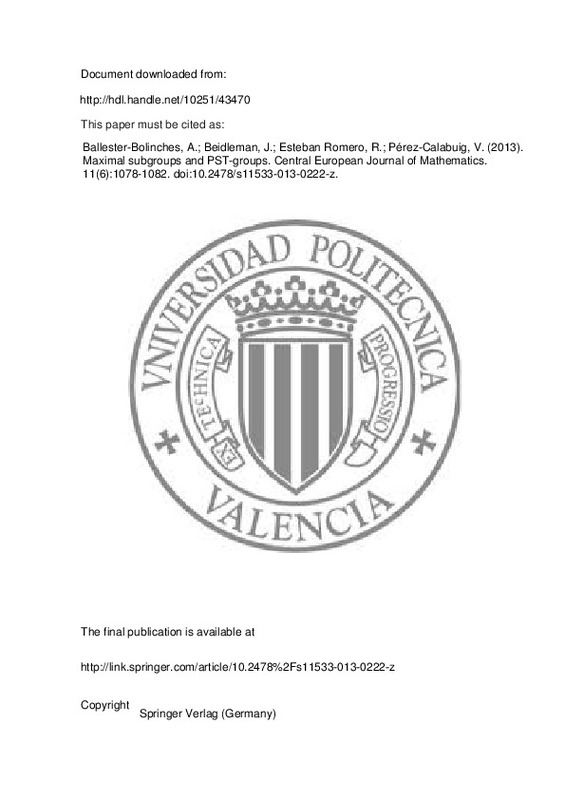JavaScript is disabled for your browser. Some features of this site may not work without it.
Buscar en RiuNet
Listar
Mi cuenta
Estadísticas
Ayuda RiuNet
Admin. UPV
Maximal subgroups and PST-groups
Mostrar el registro sencillo del ítem
Ficheros en el ítem
| dc.contributor.author | Ballester-Bolinches, A.
|
es_ES |
| dc.contributor.author | Beidleman, J.C.
|
es_ES |
| dc.contributor.author | Esteban Romero, Ramón
|
es_ES |
| dc.contributor.author | Pérez-Calabuig, V.
|
es_ES |
| dc.date.accessioned | 2014-10-22T07:48:30Z | |
| dc.date.available | 2014-10-22T07:48:30Z | |
| dc.date.issued | 2013-06 | |
| dc.identifier.issn | 1895-1074 | |
| dc.identifier.uri | http://hdl.handle.net/10251/43470 | |
| dc.description | The final publication is available at Springer via http://dx.doi.org/10.2478/s11533-013-0222-z | es_ES |
| dc.description.abstract | A subgroup H of a group G is said r to permute with a subgroup K of G if HK is a subgroup of G. H is said to be permutable (resp. S-permutable) if it permutes with all the subgroups (resp. Sylow subgroups) of G. Finite groups in which permutability (resp. S-permutability) is a transitive relation are called PT-groups (resp. PST-groups). PT-, PST- and T-groups, or groups in which normality is transitive, have been extensively studied and characterised. Kaplan [Kaplan G., On T-groups, supersolvable groups, and maxmial subgroups, Arch. Math. (Basel), 2011, 96(1), 19-25)] presented some new characterisations of soluble T-groups. The main goal of this paper is to establish PT- and PST-versions of Kaplan's results, which enables a better understanding of the relationships between these classes. | es_ES |
| dc.description.sponsorship | The first and third author have been supported by the research grant MTM2010-19938-C03-01 from MICINN (Spain). | en_EN |
| dc.language | Inglés | es_ES |
| dc.publisher | Springer Verlag (Germany) | es_ES |
| dc.relation.ispartof | Central European Journal of Mathematics | es_ES |
| dc.rights | Reserva de todos los derechos | es_ES |
| dc.subject | Finite groups | es_ES |
| dc.subject | Permutability | es_ES |
| dc.subject | Sylow-permutability | es_ES |
| dc.subject | Maximal subgroups | es_ES |
| dc.subject | Supersolubility | es_ES |
| dc.subject.classification | MATEMATICA APLICADA | es_ES |
| dc.title | Maximal subgroups and PST-groups | es_ES |
| dc.type | Artículo | es_ES |
| dc.identifier.doi | 10.2478/s11533-013-0222-z | |
| dc.relation.projectID | info:eu-repo/grantAgreement/MICINN//MTM2010-19938-C03-01/ES/PROPIEDADES ARITMETICAS Y ESTRUCTURALES DE LOS GRUPOS. APLICACIONES I/ | es_ES |
| dc.rights.accessRights | Abierto | es_ES |
| dc.contributor.affiliation | Universitat Politècnica de València. Departamento de Matemática Aplicada - Departament de Matemàtica Aplicada | es_ES |
| dc.description.bibliographicCitation | Ballester-Bolinches, A.; Beidleman, J.; Esteban Romero, R.; Pérez-Calabuig, V. (2013). Maximal subgroups and PST-groups. Central European Journal of Mathematics. 11(6):1078-1082. https://doi.org/10.2478/s11533-013-0222-z | es_ES |
| dc.description.accrualMethod | S | es_ES |
| dc.relation.publisherversion | http://link.springer.com/article/10.2478%2Fs11533-013-0222-z | es_ES |
| dc.description.upvformatpinicio | 1078 | es_ES |
| dc.description.upvformatpfin | 1082 | es_ES |
| dc.type.version | info:eu-repo/semantics/publishedVersion | es_ES |
| dc.description.volume | 11 | es_ES |
| dc.description.issue | 6 | es_ES |
| dc.relation.senia | 223670 | |
| dc.contributor.funder | Ministerio de Ciencia e Innovación | es_ES |
| dc.description.references | Huppert, B. (1967). Endliche Gruppen I. Grundlehren der mathematischen Wissenschaften. doi:10.1007/978-3-642-64981-3 | es_ES |
| dc.description.references | Doerk, K., & Hawkes, T. O. (1992). Finite Soluble Groups. doi:10.1515/9783110870138 | es_ES |
| dc.description.references | Ballester-Bolinches, A., Esteban-Romero, R., & Asaad, M. (2010). Products of Finite Groups. de Gruyter Expositions in Mathematics. doi:10.1515/9783110220612 | es_ES |
| dc.description.references | Gasch�tz, W. (1953). �ber die ?-Untergruppe endlicher Gruppen. Mathematische Zeitschrift, 58(1), 160-170. doi:10.1007/bf01174137 | es_ES |
| dc.description.references | Kaplan, G. (2010). On T-groups, supersolvable groups, and maximal subgroups. Archiv der Mathematik, 96(1), 19-25. doi:10.1007/s00013-010-0207-0 | es_ES |







![[Cerrado]](/themes/UPV/images/candado.png)

